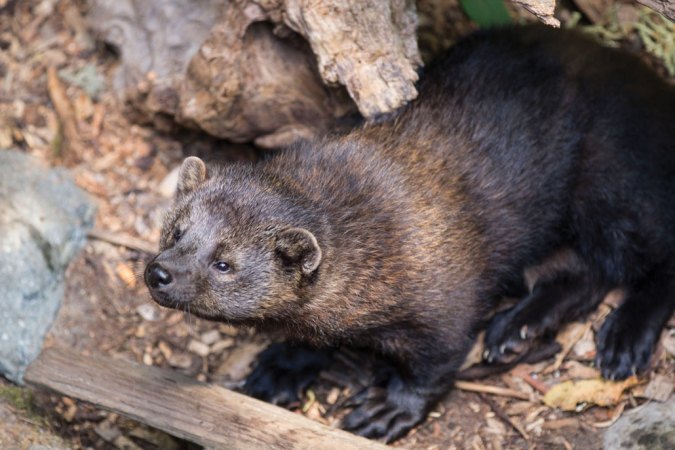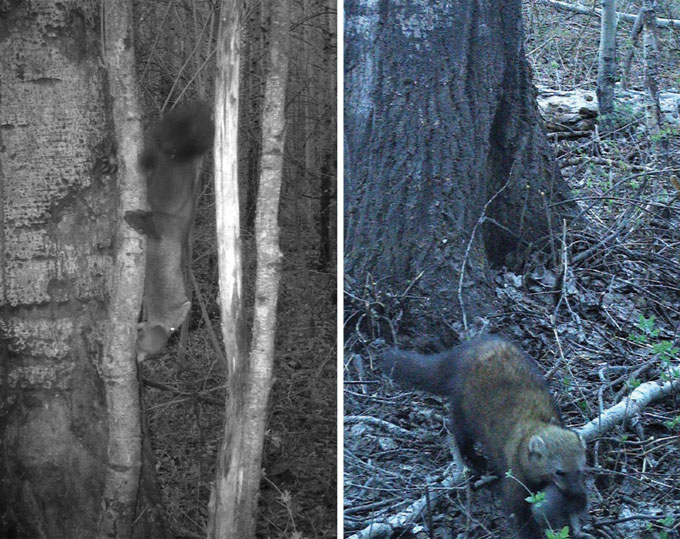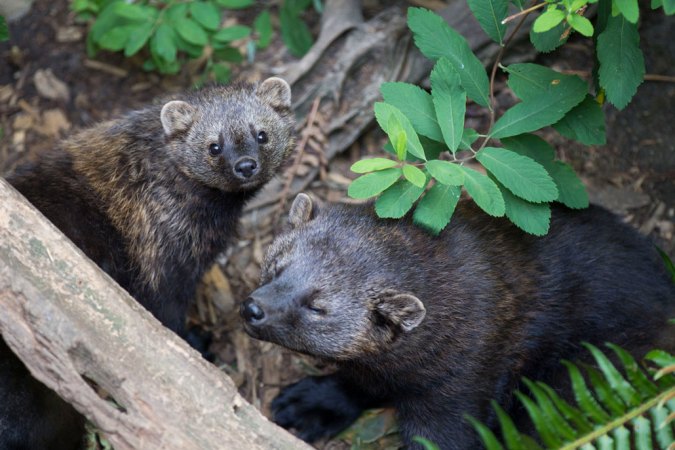Tree-climbing carnivores called fishers are back in Washington’s forests
Trapping and habitat loss had wiped out the population

A crowd gathers to watch a fisher released into Washington state’s Mount Rainier National Park in December 2016. About 280 of these tree-climbing animals have been translocated from Canada since 2008 to help fisher populations rebound.
KEVIN BACHER/NPS (CC BY 2.0)
- More than 2 years ago
Holding an antenna above his head, Jeff Lewis crept through an evergreen forest in the Cascade mountains, southeast of Seattle. As he navigated fallen fir logs and dripping ferns, he heard it: a faint “beep” from a radio transmitter implanted in an animal code-named F023.
F023 is a fisher (Pekania pennanti), an elusive member of the weasel family that Lewis fondly describes as a “tree wolverine.” Resembling a cross between a cat and an otter, these sleek carnivores hunt in forests in Canada and parts of the northern United States. But fur trapping and habitat loss had wiped out Washington’s population by the mid-1900s.
Back in 2017 when Lewis was keeping tabs on F023, he tracked her radio signal from a plane two or three times a month, along with dozens of other recently released fishers. Come spring, he noticed that F023’s behavior was different from the others.
Her locations had been clustered close together for a few weeks, a sign that she might be “busy with babies,” says Lewis, a conservation biologist with the Washington Department of Fish and Wildlife. He and colleagues trekked into the woods to see if she had indeed given birth. If so, it would be the first wild-born fisher documented in the Cascades in at least half a century.
As the faint beeps grew louder, the biologists found a clump of fur snagged on a branch, scratch marks in the bark and — the best clue of all — fisher scat. The team rigged motion-detecting cameras to surrounding trees. A few days later, after sifting through hundreds of images of squirrels and deer, the team hit the jackpot: a grainy photo of F023 ferrying a kit down from her den high in a hemlock tree. The scientists were ecstatic.
“We’re all a bunch of little kids when it comes to getting photos like that,” Lewis says.
Sign up for our newsletter
We summarize the week's scientific breakthroughs every Thursday.
Chasing babies
This notable birth came during the second phase of a 14-year fisher reintroduction effort. After 90 fishers were released in Olympic National Park from 2008 to 2010, the project turned its focus east of Seattle, relocating 81 fishers in the South Cascades (home to Mount Rainier National Park) from 2015 to 2020, and then 89 fishers in the North Cascades from 2018 to 2020. The animals were brought in from British Columbia and Alberta. The project concluded last year, when researchers let loose the final batch of fishers.
Three forests
Washington’s fisher recovery efforts relocated the animals to three regions of the state: the Olympic Peninsula west of Seattle and the North and South Cascades, a mountain range separated by Interstate 90.

Baby animals are the key measure of success for a wildlife reintroduction project. As part of Washington’s Fisher Recovery Plan, biologists set out to document newborn kits as an indicator of how fishers were faring in the three relocation regions.
Before F023’s kit was caught on camera in May 2017, biologists had already confirmed births by seven relocated females on the Olympic Peninsula, where the whole project began. Two of the seven females had four kits, “the largest litter size ever documented on the West Coast,” says Patti Happe, wildlife branch chief at Olympic National Park. Most females have one to three kits.
Lewis is often asked, why put all of this effort into restoring a critter many people have never heard of? His answer: A full array of carnivores makes the ecosystem more resilient.
Happe admits to another motive: “They’re freaking adorable — that’s partly why we’re saving them.”

The missing piece
Contrary to their name, fishers don’t hunt fish, though they’ll happily munch on a dead one if it’s handy. They mainly prey on small mammals, but they also eat reptiles, amphibians, insects, fruit and carrion. About a meter long, males weigh up to six kilograms, about twice as much as females. Fun facts: Females raise young high above the forest floor in hollowed-out spaces in tree trunks. Fishers can travel face-first down tree trunks by turning their hind feet 180 degrees. They have wickedly sharp teeth and partially retractable claws. And they’re incredibly agile, leaping up to two meters between branches and traveling as much as 30 kilometers in a day.
Fishers’ stubby legs and unique climbing skills make them a threat to tree-climbing porcupines. It isn’t pretty: A fisher will force the quill-covered animal down a tree and attack its face until it dies from blood loss or shock. Then the fisher neatly skins the prickly prey, eating most everything except the quills and bones.

But these fearsome predators were no match for humans. In the 1800s, trappers began targeting fishers for their fur. Soft and luxuriant, the glossy brown-gold pelts were coveted fashion accessories, selling for as much as $345 each in the 1920s. This demand meant fishers disappeared not only from Washington, but from more than a dozen states across the northern United States. Once fisher populations plummeted, porcupines ran rampant across the Great Lakes region and New England. This wreaked havoc on forests because the porcupines gobbled up tree seedlings.
Hoping to keep porcupine populations in check, private timber companies partnered with state agencies to bring fishers back to several states in the 1950s and 1960s. Thanks to these efforts and stricter trapping regulations, fishers are once again abundant in Michigan, Wisconsin, New York and Massachusetts.
But in Washington, like most of the West, fisher numbers were still slim. By the turn of the 21st century, no fisher had been sighted in the state for over three decades.
As in the Midwest and New England, private timber companies in Washington supported bringing back fishers. Although porcupines are uncommon in Washington, mountain beavers — a large, primitive rodent endemic to the Pacific Northwest — fill a similar role in Washington’s evergreen forests: They eat tree seedlings. And fishers eat them.
By 2006, the state hatched a plan to bring the animals in from Canada. “It was a big opportunity to restore a species,” Lewis says. “We can fix this.”
A new home
Like the other Canadian fishers moved to Washington, F023’s relocation story began when she walked into a box trap in British Columbia, lured by a tasty morsel of meat. The bait had been set by local trappers hired by Conservation Northwest, a nonprofit that is one of the recovery project’s three main partners, along with Washington Fish and Wildlife and the National Park Service. After veterinarians checked her health and administered vaccines and antiparasitics to help her survive in her new home, F023 received a surgically implanted radio transmitter and was driven across the border.
She was met by members of the fisher recovery team, who released her just south of Mount Rainier National Park. The forest’s towering Douglas fir, western red cedar and western hemlock trees were full of cubby holes and cavities to hide in, and the undergrowth held plenty of small mammals to eat. At the release, upward of 150 people gathered around F023’s box, part of the team’s effort to engage the public in championing fisher recovery. Everyone cheered as a child opened the door and the furry female bounded into the snowy woods, out of sight in a flash.
The team monitored each relocated fisher for up to two years to see if the project met key benchmarks of success in each of the three regions: more than 50 percent of the fishers surviving their first year, at least half establishing a home range near the release site, and a confirmed kit born to at least one female.
“We met those marks,” says Dave Werntz, science and conservation director at Conservation Northwest.
The effort may have been aided by a series of bypasses built over and under a roughly 25-kilometer stretch of Interstate 90 east of Seattle. One of these structures is the largest wildlife bridge in North America, an overpass “paved” with forest. In 2020, a remote camera caught an image of what looks like a fisher moving through one of the underpasses.

“Male fishers go on these huge walkabouts to find females,” Werntz says. While biologists assumed fishers would cross the freeway to search for mates, having photographic proof “is pretty wonderful,” he says.
Happe and others hope to also see wildlife crossings along Interstate 5 one day. The freeway, which runs north-south near the coast, is the main obstacle keeping the Olympic and Cascade populations apart, she says. “We’re all working on wildlife travel corridors and connectivity in hopes the two populations hook up.”
Learning curve
The majority of the initial 90 fishers relocated to the Olympic Peninsula settled nicely into their new homes, according to radio tracking. In the year following release in that location, the fisher survival rate averaged 73 percent, but varied based on the year and season they were released, as well as sex and age of the fishers.
Males fared better than females: Seventy-four percent of recorded deaths were of females, partly because they are smaller and more vulnerable to predators, such as bobcats and coyotes. Of 24 recovered carcasses where cause of death could be determined, 14 were killed by predators, seven were struck by vehicles, two drowned and one died in a leg-hold trap, Lewis, Happe and colleagues reported in the April 2022 Journal of Wildlife Management.
Because the first fishers relocated to the Olympic Peninsula were released in several locations, the animals had trouble finding mates. As a result, only a few parents sired the subsequent generations.
The researchers became concerned when they looked at the genetic diversity of fishers on the Olympic Peninsula six years post-relocation. Happe and colleagues set up 788 remote cameras and hair-snare stations: triangular cubbies open on either end with a chicken leg as bait in the middle and wire brushes protruding from either side to grab strands of fur. DNA analysis of the fur raised red flags about inbreeding, Happe and Lewis say.
“Models showed we were going to lose up to 50 percent of genetic diversity, and the population would wink out in something like 100 years,” Happe says. To expand the gene pool, the team brought 20 more fishers to the Olympic Peninsula in 2021. These animals came from Alberta whereas the founding population had hailed from British Columbia.
As the reintroduction effort moved into the Cascades, the team adapted, based on lessons learned from the Olympic Peninsula. For instance, to increase the likelihood of fishers finding each other more quickly, the animals were released at fewer sites that were closer together. The team also released the animals before January, giving females ample time to settle into a home range before the spring mating and birthing season.
Finding their food
As the experiment went on, more unanticipated findings popped up. Fishers released in the southern part of the Cascades were more likely to survive the first year (76 percent) than those relocated north of I-90 (40 percent), according to the final project report, released in June. Remote-camera data suggest that’s because there are less prey and slightly more predators in the North Cascades, says Tanner Humphries, community wildlife monitoring program lead for Conservation Northwest.
And in both the Cascades and the Olympic Peninsula, fishers are using different types of habitat than biologists had predicted, Happe says. The mammals — once assumed to be old-growth specialists — are using a mosaic of young and old forests. Fishers require large, old trees with cavities for denning and resting. But in younger managed forests where trees are thinned or cut, prey may be easier to come by.
Live traps in the South Cascades support that idea. Fishers’ preferred prey — snowshoe hares and mountain beavers — were most abundant in young regenerating forests. In older forests, traps detected mainly mice, voles and chipmunks, which are not substantial meals for fishers, Mitchell Parsons, a wildlife ecologist at Utah State University in Logan, reported with Lewis, Werntz and others in 2020 in Forest Ecology and Management.

The future is re-wild
After F023’s baby was caught on camera five years ago, the mother’s tracking chip degraded as designed — the hardware lasts less than two years. Since then, many more fisher kits have been born in Washington.
In fact, these furry carnivores are one of the most successfully translocated mammals in North America. According to Lewis, 41 different translocation efforts across the continent have helped fisher populations blossom. The animals now occupy 68 percent of their historical range, up from 43 percent in the mid-1900s.
With the last batch of fishers delivered to Washington in 2021, the relocation phase of the project has ended. Lewis, Happe and their partners plan to continue monitoring how these sleek tree-climbing carnivores are faring — and how the ecosystem is responding. For instance, fishers are indeed feasting on seedling-eating mountain beavers, according to research reported by Happe, Lewis and others in 2021 in Northwestern Naturalist.
Given climate change, species loss and ecosystem degradation, animals worldwide face difficult challenges. The fact that fishers are thriving once again in Washington offers hope, Lewis says.
“It’s a hard time, it’s a hard world, and this feels like something we’re doing right,” he says. “Instead of losing something, we’re getting it back.”





